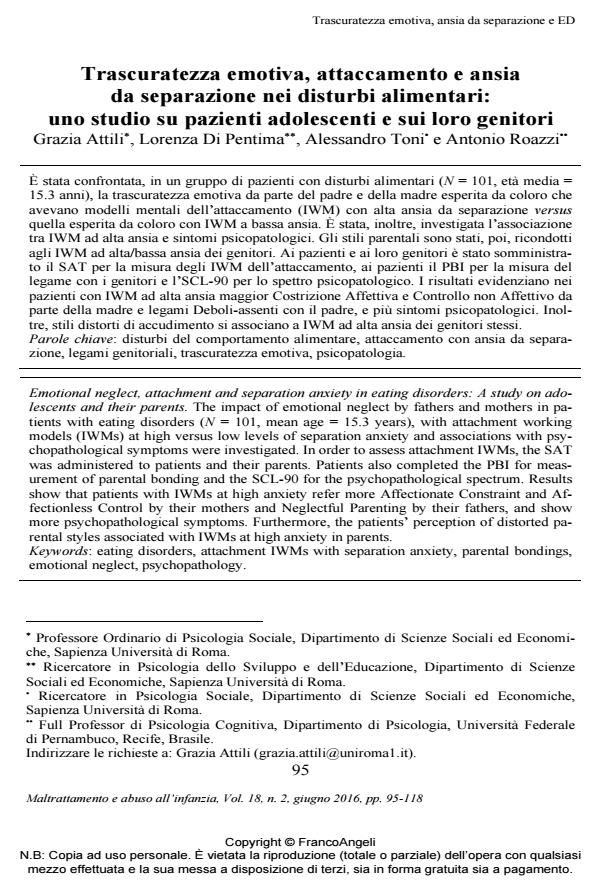Trascuratezza emotiva, attaccamento e ansia da separazione nei disturbi alimentari: uno studio su pazienti adolescenti e sui loro genitori
Titolo Rivista MALTRATTAMENTO E ABUSO ALL’INFANZIA
Autori/Curatori Grazia Attili, Lorenza Di Pentima, Alessandro Toni, Antonio Roazzi
Anno di pubblicazione 2016 Fascicolo 2016/2
Lingua Italiano Numero pagine 24 P. 95-118 Dimensione file 312 KB
DOI 10.3280/MAL2016-002006
Il DOI è il codice a barre della proprietà intellettuale: per saperne di più
clicca qui
Qui sotto puoi vedere in anteprima la prima pagina di questo articolo.
Se questo articolo ti interessa, lo puoi acquistare (e scaricare in formato pdf) seguendo le facili indicazioni per acquistare il download credit. Acquista Download Credits per scaricare questo Articolo in formato PDF

FrancoAngeli è membro della Publishers International Linking Association, Inc (PILA)associazione indipendente e non profit per facilitare (attraverso i servizi tecnologici implementati da CrossRef.org) l’accesso degli studiosi ai contenuti digitali nelle pubblicazioni professionali e scientifiche
È stata confrontata, in un gruppo di pazienti con disturbi alimentari (N = 101, età media = 15.3 anni), la trascuratezza emotiva da parte del padre e della madre esperita da coloro che avevano modelli mentali dell’attaccamento (IWM) con alta ansia da separazione versus quella esperita da coloro con IWM a bassa ansia. È stata, inoltre, investigata l’associazione tra IWM ad alta ansia e sintomi psicopatologici. Gli stili parentali sono stati, poi, ricondotti agli IWM ad alta/bassa ansia dei genitori. Ai pazienti e ai loro genitori è stato somministrato il SAT per la misura degli IWM dell’attaccamento, ai pazienti il PBI per la misura del legame con i genitori e l’SCL-90 per lo spettro psicopatologico. I risultati evidenziano nei pazienti con IWM ad alta ansia maggior Costrizione Affettiva e Controllo non Affettivo da parte della madre e legami Deboli-assenti con il padre, e più sintomi psicopatologici. Inoltre, stili distorti di accudimento si associano a IWM ad alta ansia dei genitori stessi.
Parole chiave:Disturbi del comportamento alimentare, attaccamento con ansia da separazione, legami genitoriali, trascuratezza emotiva, psicopatologia
- Dysfunctional Parental Care and Emotional Dysregulation: A Pilot Study on the Mediating Role of Attachment Styles and Alexithymia in a Sample of Young Women Lorenza Di Pentima, Alessandro Toni, in Journal of Adult Development /2025
DOI: 10.1007/s10804-025-09523-z - Associations between Adverse Childhood Experiences Subtypes and Eating Disorders: A Systematic Review Marina Angela Visco, Maria Rosaria Juli, Venusia Covelli, Elena Camisasca, in MALTRATTAMENTO E ABUSO ALL'INFANZIA 1/2025 pp.13
DOI: 10.3280/MAL2025-001002 - A letto senza cena. I danni di una strategia educativa fallace sul comportamento alimentare dei minori Carolina Tognon, in MALTRATTAMENTO E ABUSO ALL'INFANZIA 2/2024 pp.97
DOI: 10.3280/MAL2024-002006 - High Anxiety Attachment in Eating Disorders: Intergenerational Transmission by Mothers and Fathers Grazia Attili, Lorenza Di Pentima, Alessandro Toni, Antonio Roazzi, in Paidéia (Ribeirão Preto) /2018
DOI: 10.1590/1982-4327e2813
Grazia Attili, Lorenza Di Pentima, Alessandro Toni, Antonio Roazzi, Trascuratezza emotiva, attaccamento e ansia da separazione nei disturbi alimentari: uno studio su pazienti adolescenti e sui loro genitori in "MALTRATTAMENTO E ABUSO ALL’INFANZIA" 2/2016, pp 95-118, DOI: 10.3280/MAL2016-002006